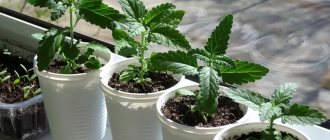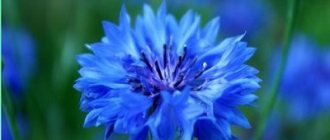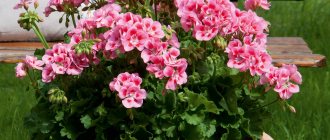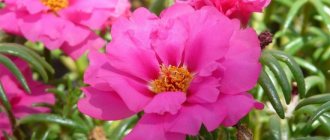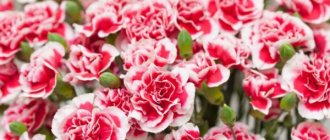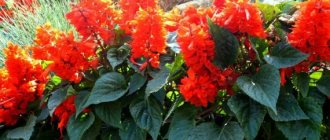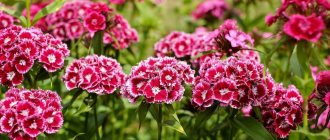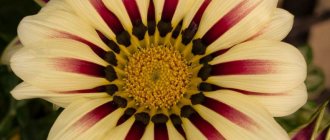Amaranth (from Latin Amaránthus) – this annual perennial is popularly called amaranth. Flowers are often found among gardeners because they have not only smooth outlines and decorative forms, but also useful properties. The flowers have high decorative qualities, and the variety of species allows you to choose not only the one that suits the landscape, but also the most unpretentious variety.
Botanical description
It is an annual, less often perennial, herbaceous plant belonging to the Amaranth family. The decorative effect of the bushes is due to their even shape and size, which is why acorn bushes are also called “soldiers” in the garden. Culture is used not only in decorative, but also in culinary arts.
It is typical for Amaranthaceae to have a thick trunk, elongated leaves and racemose inflorescences formed by many small flowers. The plant blooms for a long time, so it decorates the garden area for several months. This crop reaches a size from 30 cm to 3 meters, therefore, by selecting a variety, you can improve the area in various ways. There are varieties colored purple-red.
The rhizome is thick and strong, goes deep into the soil. Many subsidiary branches extend from the main stem. The root collar is powerful, and a thick and strong stem extends from it. Depending on the variety, the stems may branch or not. Most species are characterized by deepening of the rhizome stem to a depth of more than half a meter.
The entire plant from the base is covered with foliage - elongated, rounded leaf plates with smooth edges, of a bright green hue. They are attached to the plant using a petiole. The surface of the foliage is covered with a network of veins. They are located alternately on the stem. A notch is visible at the top of the leaf plate.
It blooms with axillary inflorescences collected in large drooping racemes. The apical flowers are located at the tips of the shoots. The small flowers that make up the brush can be of different colors - red, purple, white, violet.
In place of the flowers, after the petals fall, a fruit is formed - a box with seeds. More than one and a half million amaranth seeds can form on one bush.
Spreading
Amaranth has been cultivated for several centuries. However, wild varieties were mentioned in culture more than 8 thousand years ago. The first mentions of amaranth were noted in the southern regions of America, which is why it is considered the birthplace of this flower. Today culture is found everywhere.
In some countries, Amaranth is grown as a cultivated plant and on an industrial scale. Thus, in India and some regions of China, flour and bread are made from amaranth. The Japanese value ashiritsa, placing it on the same level as squid meat.
In European countries, agaricum is grown as an ornamental annual plant. Many varieties have gone wild here and began to grow like weeds.
Types and varieties
Shchiritsa has more than 60 species in its genus, among which about 30 are popular. Such plants have an unpretentious disposition and are resistant to cold and humidity. Each variety presented has its own characteristics and differences. It is necessary to choose amaranth carefully, since by mistake you can purchase not only decorative, but also fodder varieties of the plant.
Amaranth caudate
It is a tall and durable bush, about 1.5 meters in size. The plant is erect, with a powerful rhizome, dense and thick stem and bright green foliage. The leaves are large, with smooth edges, and hang downwards on the plant. With the help of a strongly recessed rhizome, the bushes do not bend towards the ground even in strong winds.
A special feature of the tailed amaranth is the release of a racemose inflorescence in early June, drooping down in the form of a small tail. The long stalk holds many small flowers in one place, forming a fluffy and decorative inflorescence. In some varieties, the peduncle grows by half a meter.
Rotschwant
Small erect herbaceous shrubs reaching a size of 70 cm. They are distinguished by their spreading nature - the bushes spread a meter or more in width. The foliage of this variety is slightly ribbed and rough to the touch. The racemose inflorescences form several clusters in the form of a panicle. Thus, one panicle can consist of 50 or more flower stalks hanging down from the top of the plant. It is noted that the size of peduncles can reach a size larger than the bush itself. In this case, the flower stalks are located on the ground. The flowers are predominantly red or burgundy.
Grunschfwarz
The appearance of the plant is similar to the previous variety, but the subspecies blooms with rich green racemose inflorescences. Gardeners often grow both varieties locally, since they not only have equal sizes, but also get along well with each other and do not cross. The flowers last for a long time if the brushes are dried and dried.
Raspberry beads
The peculiarity of this flower is the presence of red stems. The bushes themselves are about a meter in size, covered with green foliage with carved edges. The bushes grow strongly on the sides, suppressing the growth of neighboring plants, so they are planted separately.
The inflorescences are bright crimson in color, the racemes hang from the tops for a meter or more, sometimes descending to the ground. Amaranth blooms for a long time, maintaining its decorative effect even after drying.
Amaranth Green Tails
Small plants, reaching a maximum size of 80 cm. The variety is considered one of the rarest, since all the outer parts of the bush are the same green color. This shrub is valued for its bright and long raceme-like inflorescences, hanging down more than half a meter. The bushes themselves are powerful and stand tightly in an upright position. The plants are often planted as hedges because they are so dense that they can protect other crops from the wind.
Avalanche
It is distinguished by decorative inflorescences, the flowers of which look like beads hanging from the top of the bush. The brushes are collected in bunches, forming panicles. Growing this crop will require an abundance of light, so they are planted separately from other plants.
Green torch
Small annual plants, no more than half a meter high, with bright, rich foliage. Leaf plate with smooth edges, rounded shape. Despite its small size, the crop stands on a powerful stem. The variety does not tolerate cold. In favorable conditions it blooms throughout the summer and autumn, until the onset of cold weather. Another feature of the shrub is the vertically upward clusters of inflorescences. Blooms bright green.
Dreadlocks
The most interesting representative of amaranth. It is classified as both caudate and paniculate amaranth, due to the peculiarities of the development of the inflorescence. Together, the brushes gathered into a panicle resemble dreadlocks, which first rise at the top, then hang down. Amaranth blooms with burgundy inflorescences that look like balls. The burgundy color of the panicles and greenery creates a decorative look for the garden.
Amaranth bicolor or tricolor
A peculiarity of representatives of this type of amaranth is the color of the foliage, which combines several different shades. At the same time, different colors are located already at the root.
The foliage of bicolor amaranths is elongated and can have a red=yellow or red-orange color, or a green tint. The height of various bushes ranges from 50 to 80 cm, but some representatives reach one and a half meters.
You may be interested in: Shepherdia
Illuminations
It is considered the most decorative representative of amaranth, since it combines several colors at once. The foliage shimmers from red, yellow, to green. Many leaves contain all the colors on one leaf blade. The height of the bushes does not exceed 60 cm, so the plants combine decoratively with other crops in the garden. Young leaves intensify their color as the season progresses, reaching maximum contrast in autumn.
Glamorous glitter
The plant is about half a meter in length. It is a smooth and compact bush, decorated with large leaves. The bottom of the plant is dark green, and towards the top the foliage becomes dark burgundy. The solemn appearance of amaranth does not leave gardeners indifferent.
Molten fire
Tall shrub, reaching 80 cm upward. The foliage below is colored brown, and above it takes on burgundy and scarlet shades. The foliage at the bottom of the shrub is round in shape, while at the top the leaves are elongated, with jagged edges.
Early Splender
An annual representative of bicolor amaranths. It is a tall shrub, about a meter in size, with raspberry-burgundy foliage. The trunks are branched and uneven in shape. Lower foliage with a bronze tint. In the garden, shrubs are often planted next to petunias as a background plant.
Aurora
Bicolor amaranth, the size of which is about 120 cm. The foliage is yellow-green in color, elongated in structure, with jagged edges. The leaves are cream colored on top. It is grown in the garden both with other two-color amaranths and as a separate crop.
Splendence perfecta
Amaranth is a tricolor, cone-shaped, about 1.2 meters in size. The plant prefers single cultivation, because in combination with other varieties it quickly crosses and loses varietal characteristics. The foliage is petiolate, narrow and long. The lower part of the foliage is black, with spots, the upper part is variegated, yellow-red. The decorative effect of the shrub remains throughout the entire season.
Bicolor
The structure of the bush is pyramidal, height is about 90 cm. The lower part of the leaves is dark green, towards the top it takes on a burgundy or bright red outline. The leaves are wavy, elongated in structure. The crop must be grown in sunny areas, as it loses color in the shade.
Amaranth paniculata
A type of amaranth called scarlet. It is an erect fluffy shrub with an abundance of branches. In the garden it grows significantly in different directions, therefore it is cultivated separately from other crops.
The peculiarity of the species is the predominantly vertical arrangement of panicle inflorescences. Only some varieties have drooping panicles due to their heaviness. The size of the main varieties is 35-130 cm. Depending on the size, the crop is divided into low, medium and tall.
Oeschberg
A variety of paniculate amaranth, which is a hybrid of German origin. The size of the crop is approximately a meter. The plant branches heavily, due to which it takes up a lot of space in the garden. Dark green foliage of elongated shape, petiolate. Panicles burgundy color. With high-quality lighting, the color of the panicles changes to brighter and more saturated.
Twins
Shrubs differ in different tones of peduncles. There are green and burgundy color of the panicles. In the middle of the lush bush, a central peduncle is formed - a panicle inflorescence, reaching half a meter in size. The lateral inflorescences do not exceed 10 cm in length. The central peduncle is about 7 cm in diameter and consists of many small flowers. The culture itself is relatively tall and spreading, no more than 80 cm in height. The central trunk is strong and can withstand strong winds without drooping.
Bronze
The tallest representative of amaranth paniculata. It is a two-meter tall plant, with a thick stem that can withstand the weight of many side branches with foliage and inflorescences. The panicles are large, erect, yellow-orange in color. The plant blooms all summer, until frost. Decorative dried flowers are often left over for the winter. The plant lives in sunny areas.
Red Cathedral
A fairly tall representative of amaranth, the size of which is about 1.3 meters. Bright green foliage combined with towering crimson clusters will give the garden an unusual appearance. Blooms for a long period of time. You can grow a crop in the garden only through seedlings.
Bronze Age
The appearance of this variety is similar to the two previous representatives. The variety differs only in its inflorescences - they are bronze. The more light used during cultivation, the brighter the tone of the panicles.
Red torch
A dwarf representative of the paniculate species of amaranths. Despite its small size, it is a shrub with a dense trunk and powerful side shoots. The inflorescence is located mainly in the center of the plant. Blooms with burgundy racemose inflorescences. The disadvantage of this variety is considered to be intolerance to even light frosts. Therefore, the crop is grown mainly in warm, mild climates.
Amaranth fodder
The species category is distinguished by abundant greenery and large flower stalks. The plant is actively used as livestock feed. The plant is unpretentious to any cultivation conditions. It has high productivity.
Giant
A varietal category included in the state register of our country. Shrubs with dark foliage. It blooms with a yellow or red panicle, differing in width and considerable height - the flowers are difficult to grasp with two hands, they hang down 40-50 cm. The plant has abundant foliage and is used as silage. The plants themselves are giants, their size reaches 2 meters. high yield is about 20 tons per hectare.
Lera
The fodder variety, more than 2 meters in size, is characterized by long fruit ripening periods - up to 105 days after planting. The annual has green foliage and stems with red veins. Blooms with red racemose inflorescences. The length of the panicle is just over half a meter. The plant is abundantly covered with foliage and is used as food as the greens of the plant contain essential nutrients.
Aztec
Varietal category with red leaves and inflorescences. Ripens later, preserves flowers until frost. The height of the crop is approximately one and a half meters. The panicles are red, about half a meter in size, hanging down. Flowering and fruiting are abundant.
Kizlyarets
Harvesting of this variety begins 2 months after planting. Used for making silage. The culture consists of extensive shrubs, more than one and a half meters in size. The abundant foliage makes this variety dominant in cultivation. The shrubs are resistant to fungal diseases and pests and are characterized by high productivity.
Cherry jam
A unique representative used for medicinal, food and feed purposes. Quite low-growing shrubs, not exceeding 80 cm in size. The plant is herbaceous and is grown as a perennial in warm climates. It blooms with cherry panicles hanging from the top of the bush. Productivity is high.
Dark amaranth
Compact shrubs, few branches, slightly more than one and a half meters in size. Lanceolate foliage is elongated, purple in color with a hint of green. The bushes grow vertically upward, the inflorescences are erect, dark burgundy or black in color. There is a variety with drooping inflorescences of a bright red hue. the height of common crops is 40-60 cm. The species is used for cutting into bouquets.
White amaranth
Low-growing, few-branched shrubs, about half a meter in size. The foliage of these representatives is light green, almost white. the inflorescences are also snow-white, hanging separately. Some representatives bloom in clusters of heavy inflorescences. drooping flowers.
Red Amaranth
A decorative representative of amaranth, distinguished by bright red leaves and stem. At the same time, the inflorescences differ in shade; they are more saturated and bright. The size of the bush is 2 meters. The stems of the crop are thick, branched, powerful, and can withstand strong winds.
The variety blooms with dark red or burgundy panicles-inflorescences. shrubs are distinguished by their unpretentiousness to cultivation conditions. The peculiarity of the species is its ability to protect the soil from wind erosion.
Amaranth upturned
A weed, popularly called "garden soldier". The size of the crop is one and a half meters. A plant with a red or brown stem, characterized by abundant branching. The roots of this crop are pink. Shrubs grow strongly and, when living in vegetable gardens, interfere with the growth of other crops.
It blooms with a spike-shaped inflorescence of a gray or yellow hue. The flowers are spiny, with an abundance of small black seeds.
Cherry velvet
Decorative representative of amaranth, small in height. The plant is red in color, just over 50 cm tall. It blooms with scattered spikelets, openwork in structure. Individual crops turn purple. The crop can only be grown on loose and fertile soil. The annual plant freezes at the first frost.
You may be interested in: Levisia
Vegetable amaranth
Mainly an ornamental crop used for food. The flowers and foliage of this amaranth are edible and full of useful substances. Different varieties have a height of 30-70 cm and are used for preparing various dishes.
Indoor amaranth
Any variety of amaranth can be grown at home. At the same time, the culture acquires a more compact size. Low-growing varieties such as Rother Dam, Hot Biscuit, and Grunefakel are often used as indoor plants. Caring for these plants is not difficult. The culture is unpretentious and does not differ in care from other indoor crops.
Types of amaranth
There are many types of amaranth, and they are grown for completely different purposes. There are forage, vegetable and ornamental crops, and there are also ordinary wild weeds.
Vegetable amaranth
This species quickly and actively grows abundant foliage. It is edible along with shoots and grains. Vegetable amaranth is considered the most useful among its relatives.
Photo: kartoska.ru
Yellow amaranth
A compact decorative variety with a height of only 70 cm. One bush can have leaf blades of different shades of green, orange, yellow and bronze. The inflorescences are also yellow.
Photo: floweryvale.ru
Tricolor amaranth
This amazing species belongs to the decorative deciduous species. Each leaf is painted in several colors at once - green, yellow-orange and crimson. Its inflorescences are also large, bright yellow-red.
Photo: kartoska.ru
Tailed amaranth
A beautiful ornamental annual with large pendulous clusters that last until October. The varieties whose shoots are purple are very impressive.
Photo: 2sotki.ru
Dark amaranth
A tall, low-branching species up to 1.5 m tall with decorative erect inflorescences. Both the flowers and pointed leaves have a striking purple hue.
Photo: amaranth-ukr.com.ua
Upturned amaranth
This more compact and less branched species reaches an average height of 1 m. It has green inflorescences, a very powerful tap root, fleecy shoots and large ovoid leaves up to 14 cm in length.
Photo: 2sotki.ru
Paniculate amaranth
It is simply red, with red elongated inflorescences, which can be straight or drooping. It has very powerful, strong shoots up to 1.5 m tall.
Photo: zen.yandex.ru
Monarda (50 photos): types, planting and care in open ground
Planting at home
Despite the fact that most amaranth varieties are large in size, any type can be grown at home. At home, the plant acquires a compact size, grows well and develops on a window or balcony.
At home, purchased amaranth seedlings or seeds are planted. Planting material is placed in a nutritious and loose substrate. The soil used is neutral soil, consisting of peat and a large amount of sand. The health of the bush depends on the quality of the drainage layer and the nutrients in the composition.
Since some varieties grow strongly, a large and wide pot is used for amaranth. A sufficient amount of space will ensure normal development of the root system. Amaranth is not transplanted, since even at home it grows as an annual.
Growing seedlings
Amaranth is sown in April. Seeds are planted in containers with moist soil. Seeds are sown one at a time, in furrows about 1.5 cm deep. After placing the seeds, the furrows are sprinkled with a layer of earth. It is recommended to maintain a distance of about 5 cm between the rows. In this form, the seeds germinate quickly, producing the first shoots within a week. If necessary, seedlings are thinned out, leaving a distance of about 7 cm between individual bushes.
After the crop reaches a size of about 10 cm, it is planted in separate pots. Immediately after this, fertilize with nitrogen fertilizer. Flowers ripen in the 3rd-4th month after cultivation.
Home care
Pots with amaranth are placed in well-lit areas, in direct sunlight. If there is insufficient lighting, it is created artificially.
Amaranth grows in warm climates. The optimal conditions for growing crops are 18-20 degrees. The plant cannot tolerate low temperatures and dies at 6 degrees above zero.
There is no need to spray amaranth regularly. The plant does not require constant moisture and grows well in dry conditions. However, for normal development, the bush is regularly washed in the shower.
Watering indoor amaranth is carried out as the top layer of soil dries. The plant has good hardiness and drought resistance.
During the active growing season, 3 fertilizers are applied to indoor amaranth:
- The first fertilizing is carried out before planting the seeds. Superphosphate is added to the soil;
- After the appearance of 3 permanent leaves, a complex of minerals is added;
- Before flowering, a mineral complex is also added.
An important condition for growing amaranth is its instability to inorganic fertilizers, which cannot be applied to the soil.
Popular plant varieties
An ornamental garden plant has delighted gardeners with its very attractive and very original appearance, as well as many beneficial properties for eight thousand years. During this time, domestic and foreign breeders have bred a huge number of varieties and varieties that differ in appearance and level of demands on growing conditions.
Amaranth Illumination
The tricolor variety of amaranth is a very beautiful and spectacular plant; the above-ground part of the bushes reaches a height of 50-70 cm. It is distinguished by fairly large leaves, painted in various shades and colors. The leaves that have recently appeared at the apical part have an attractive yellowish-red color, which gradually and smoothly turns into a reddish-orange color. All other foliage is painted in bronze shades.
Amaranth Illumination
Amaranth Molten fire
This is a very impressive and original decorative garden crop , favorably distinguished by its unusual two-color foliage coloring. The leaves of this variety are red-raspberry and chocolate brown in color. The culture is moisture-loving and heat-loving, and is also capable of growing and expanding very quickly, but does not tolerate frost at all.
Amaranth Molten fire
Amaranth Brazilian Carnival
One of the varieties of the popular amaranth tricolor is a medium-vigorous ornamental deciduous garden plant with elongated ovate leaves. A characteristic feature of the variety is the formation of tricolor foliage with green-yellow, red-burgundy and pinkish-burgundy tones, which allows the crop to be used in single and group plantings on lawns. Ideal for creating a background on borders and mixborders.
Also read: Incarvillea or garden gloxinia: planting and growing, care recommendations
Amaranth Brazilian Carnival
Amaranth Raspberry beads
The above-ground part is no more than 80-100 cm high. The variety belongs to the category of fast-growing annuals with the formation of a powerful and branched stem part, which allows this variety to be used for decorating walls, fences, and low buildings.
Landscape designers use this variety when designing high borders and hedges. Alone, the plant looks harmonious in the central part of large flower beds and in mixed plantings. Groups of bright bushes look great against the background of conifers. Can be used to make bouquets.
Amaranth Raspberry beads
Planting in open ground
Growing amaranth in the garden is not difficult. The main difficulty arises only at the beginning of cultivation, when the bushes are just beginning to actively grow. You can get ready-made plants from seeds or seedlings purchased in a store. In the first case, the seedlings slowly gain growth, which is why gardeners often worry. With sufficient light, humidity and watering, amaranths develop quickly, beginning to bloom within a few months after planting.
Amaranths grown in the garden are unpretentious to cultivation conditions. The plants grow actively among weeds, do not require regular watering, and are drought and wind resistant.
How to plant amaranth
You can grow an annual from seeds or seedlings. In the second case, the crop is pre-grown in containers, then transplanted into the soil when the soil warms up to the optimal temperature.
Planting amaranth using seeds is also not difficult, but requires careful attention to detail. Sowing is carried out at the end of April, when the soil warms up to a thickness of about 5 cm. Planting material is sown 1 at a time, in pre-prepared holes 1.5-2 cm deep. It is recommended to maintain a distance of at least half a meter between rows, and 7-10 cm between seeds. Despite the fact that the seed is small, gardeners prefer to immediately divide the seeds among themselves.
When planted in open ground, the seeds germinate quickly. When their size reaches 15-20 cm, and permanent leaves appear on the crop, the seedlings are pruned or thinned out. At the same time, the soil is fertilized with nitrogenous fertilizer. With optimal care, the seeds sprout within the 3rd month after sowing.
Growing through seedlings
Amaranth is planted through seedlings at the end of March. Nutritious and loose soil is poured into the container, which is slightly compacted and moistened. The seeds are distributed over the surface of the soil, then lightly sprinkled with soil. For quick germination, create greenhouse conditions by covering the planting with film. The crops are ventilated regularly.
After the first shoots appear, the seedlings are opened and placed in a bright, warm place for further growth. After permanent leaves appear, the seedlings are planted in different pots. With regular watering, already on the 20th day the bushes are ready to be transplanted to a permanent place, but the procedure is carried out at the end of May, when the soil has warmed up sufficiently.
Before transplanting into open ground, seedlings are fed with nitroammophos.
When to pick amaranth
As soon as 2-3 leaves appear on the plant, you need to pick. To do this, the strongest plants are selected, the weak ones are discarded. Nutrient soil is poured into separate containers, moistened and transplanted. The soil around the seedling is slightly pressed.
Further care of the seedlings consists of fertilizing and watering. Drying out the soil is not acceptable, but waterlogging is also destructive. Amaranth seedlings should be fed with a complex mineral fertilizer for flower crops, which contains all microelements.
Amaranth seedlings should be hardened off by periodically taking them outside as soon as the weather permits.
Care
Caring for amaranth is easy. During the first months, care is taken to ensure that the seedlings do not come into contact with weeds. This is due to the slow growth of a young crop, which may stop developing due to weeds. Young crops also need regular loosening to ensure the supply of oxygen to the roots. Adult plants are resistant to temperature changes, prolonged drought and other living conditions, and therefore do not require regular inspection.
The soil
Garden amaranths grow actively in a neutral environment. It is optimal to plant the plant in soil with equal parts of peat, sand and garden soil. After planting, the soil layer is mulched to prevent the development of weeds and drying out of the soil.
Watering
Garden amaranths are watered several times a week. As they grow, watering is reduced and done once a week, or 2 times in dry climates.
Trimming
When the crop grows 25-30 cm upward, the stems are cut. After pruning, only a few buds should remain on the stems for development. Side branches are also pinched to fluff up the crop.
Top dressing
After planting in open ground, garden crops are recommended to be fed with mullein or green manure. Fertilizers are applied in the morning to moist soil.
Weeding and loosening
Weeding and loosening of amaranth is carried out only in the first 2 months after planting. When the plant begins active growth, weeding and loosening are reduced. The soil in the area where amaranth grows is mulched to maintain the required level of moisture.
Air humidity
For garden amaranth, air humidity is important only in the first months after planting. It is maintained by spraying the crop. The procedure is carried out in the morning or evening hours.
Location
Amaranth is a light-loving plant, so it is planted in sunny areas, away from drafts. The plant is not afraid of direct sunlight, and prolonged shading leads to inhibition of flowering.
Temperature
The flowers are thermophilic. The annual grows actively at temperatures of 18-25 degrees. The plant does not tolerate frost and dies at temperatures of 6 degrees and below.
Transfer
Since amaranth is primarily grown as an annual, it does not require replanting.
Amaranth diseases: prevention measures, treatment
The crop is most vulnerable to fungal diseases (root rot) during high humidity. At the first signs (these are dark spots on the surface and roots of the plant), treatment should be carried out with colloidal sulfur or fungicides (sulfur color, copper sulfate, etc.). Plants from the Amaranth family are least resistant to the following infections:
- Blackleg is a disease that affects the root system of seedlings, covering it with a dark fungus. The stem withers and the plant dies. Its development is favored by such factors as:
- excess humidity;
- dense planting;
- high soil acidity;
- poor ventilation of greenhouses or greenhouses in which young shoots are grown.
To prevent the disease, it is recommended to treat amaranth roots with a manganese solution in a proportion of 3-5 g before planting in open ground. for 10 liters of water. Trichodermin, a biological remedy against root diseases, is recommended for the treatment of the disease.
- Fomoz is a fungal infection that is activated by insufficient humidity. The root becomes darker, and the leaves and stems become covered with white spots with a purple edge. Before planting amaranth , the soil should be treated with thiazone or furadan - the products also help fight pests. For medicinal purposes, spraying with 1% Bordeaux mixture is organized.
Amaranth after flowering
After flowering, achenes are formed - amaranth fruits. If you want to grow a crop for the next year, harvest it. Seeds are collected from the healthiest plants when the lower foliage and stem have dried out. The inflorescences are cut from the plant and placed until completely dry in a well-ventilated area.
You may be interested: Eustoma is a wonderful symbol of tenderness and courage, a variety of colors
When the panicles are completely dry, by rubbing with your hands, the dry seeds easily fall out of the box. The seed material is sifted through a sieve and placed in paper bags for storage. Seed germination is maintained for 5 years.
Amaranth in landscape design
When designing various compositions with this plant, you need to take into account the size and height of the bush.
Amaranth in the form of a “tree” is well suited for large flower arrangements, as well as for a hedge or tapeworm (single plant). The foliage and inflorescences of various amaranths can harmonize perfectly with ornamental shrubs (barberry, viburnum), perennials and annuals. The combination of reddish-violet and red amaranth with yellowish, white and silvery low-growing crops (rock alyssum, evergreen iberis, jasmine) looks especially original. Amaranth will also look good against the background of lawn grass.
This culture can be used not only for decoration, but also for making salads. Vegetable amaranth grows well in the garden.
There is always a place for amaranth in the garden, as it will decorate flower arrangements throughout the summer and autumn.
Reproduction
Amaranth can be propagated in several ways. Each reproduction method has its own characteristics. Most often, the plant is produced by seed, since annuals are not able to share cuttings or roots.
The seeds are collected in the fall, when the plant dries out. It is important to collect the seeds in time before they fall to the ground. In the spring, collected and dried seeds are planted in open ground or in containers to obtain a new crop.
Common mistakes when growing seedlings
When growing amaranth seedlings, summer residents make mistakes that lead to the death of the plants. The most common ones include:
- incorrectly chosen landing site. Planting the plant on a loamy type of soil leads to the fact that amaranth grows weakly and does not form buds. To correct the situation, humus is added to the soil in a proportion of 10 kg per 1 m2 and river sand 5 kg per 1 m2;
- too early planting in open ground. The plant does not tolerate night frosts well. If the seedlings have outgrown and need to be planted in the ground, then cover the bushes with film or plastic bottles at night;
- planting seeds too deep. The planting material is not deepened, otherwise the seedlings will be uneven, or the seeds will not germinate and will rot.
Another mistake when growing seedlings is sowing seeds too thickly. If the seedlings have sprouted densely, thinning is carried out, leaving the plants at a distance of 1 cm from each other. Such actions also facilitate the picking process in the future.
Amaranth is a common plant among summer residents. Caring for the crop is undemanding, so even a beginner can handle it. In order to get a lush bush, it is recommended to grow amaranth in seedlings, and only after that transplant the plants into open ground.
Diseases and pests
Shchiritsa is considered a plant that is used as fertilizer after drying. The culture has a positive effect on other plants and improves the composition of the soil. However, the plant itself is vulnerable; if not properly cared for, it can be damaged by pests and become sick.
Diseases
The main disease of acorn grass is considered to be a fungus that attacks the rhizome and the outer part of the crop when the soil moisture is high. Fungicidal solutions are used as treatment methods, which are sprayed onto the crop several times.
Pests
Among the pests that settle on amaranth are aphids and weevils. In the first case, the insect spreads throughout the crop. Weevils settle on stems. Pests can be eliminated by treating the bushes with insecticides.
Pests
This crop variety is not susceptible to pests. But sometimes placing amaranth close to other garden plants can cause damage.
The main pests of amaranth:
| Name | Signs of appearance | Ways to fight |
| Aphid | Light spots on the leaves, sticky coating on the shoots, dejected appearance of the plant | Spray with Decis or Inta-vir |
| Weevil | Small holes on the plates, premature wilting of peduncles, | Treatment with Fufanon or Kemifos. Repeat the procedure after a week, alternating medications |
Aphid
Chemical composition
Amaranth has a unique chemical composition. All parts of the plant are used, including the seeds, roots, leaves and stem. The chemical composition of the plant is unique, containing elements such as:
- protein;
- polyunsaturated acids – linoleic, linolenic, oleic;
- flavonoids and vitamins;
- pectin and carotene;
- iron;
- copper, sulfur, phosphorus;
- sodium, magnesium, potassium, calcium.
In terms of protein content, amaranth is not inferior to meat or soy. However, amaranth protein is absorbed much better than in these products. The seeds are of the greatest value because they are considered dietary products due to the absence of gluten.
How to plant amaranth?
Amaranth seedlings should be planted in well-warmed soil, when there is complete confidence that the frosts have passed, this is the middle or end of May. The soil should be light with nutrients and some lime. Although amaranth is not whimsical by nature, excessive amounts of moisture and frosty air can prevent its further growth, so watering should be moderate, but at the same time sufficient, and when cold weather returns, you may have to cover the area with the plants.
Application
Amaranth is used not only as an ornamental crop. Some types are used in the agricultural industry, cooking and medicine. In some countries the plant is used as a vegetable.
At home
The main household purpose of amaranth is food. Various varieties of the crop are used for livestock feed in fresh form and in the form of silage. The vegetable species is used as a delicacy. Many countries grow amaranth plantations, thanks to which the plant is considered one of the most popular grains in many countries.
In cooking, grains are used that taste and smell similar to nuts. Drinks, sauces and confectionery products are made from them. The stems and leaves are suitable for fresh consumption, in salads, in a cooked state - side dishes, for fish and meat dishes.
In cosmetology, amaranth is used as an oil and extract. Such products are enriched with vitamins and minerals that saturate the skin with essential elements. Under the influence of the substances, the skin is restored and becomes more elastic. The development of cancer cells is prevented. The preparations moisturize and nourish the skin. Under the influence of oil, cell aging slows down.
In medicine
Amaranth grains are used in traditional medicine. The plant has a general strengthening effect on the heart and blood vessels, stimulates the development of immunity, and helps fight flu and colds. Based on the culture, drugs with a calming and strengthening effect on the central nervous system are prepared.
Preparations with amaranth are used to treat diseases such as hemorrhoids, inflammatory diseases of the genitourinary system, and diabetes. Amaranth improves metabolism, which is why it is used in anti-obesity medications. The healing properties of amaranth have led to the use of the plant for burns, periodontitis, and stomach ulcers.
The following properties of amaranth are also known:
- improvement of hormonal levels;
- analgesic effect;
- facilitates the course of the disease;
- restores skin.
The plant is used not only as part of medicines. In some countries, amaranth teas and infusions and tonic decoctions can be purchased in pharmacies.
In folk medicine
For traditional medicine, amaranth is a storehouse of useful substances that is used to treat many diseases. The plant nourishes the body and has a strengthening and healing effect. Based on it, various decoctions and infusions are prepared that can not only cure, but also lift your spirits.
Recipes
- If wounds appear on the skin, lubricate the damaged surface with amaranth oil 3-4 times a day
- Tonic infusion - 2 tbsp of dry amaranth powder is poured with 2 cups of boiling water, covered with a lid and placed in a dark, warm place to infuse for half an hour. Take the infusion 2 times a day, half a glass before meals.
- To strengthen the immune system, pour 10 grams of fresh crushed amaranth leaves into a glass of boiling water and cook in a water bath for 20 minutes. The broth is filtered and taken half a glass twice a day.
- Bath with amaranth - 0.5 kg of fresh greenery is poured into 2 liters of boiling water and boiled for a quarter of an hour, then infused for another half hour. The finished broth is filtered and poured into the finished bath. Take this bath for at least half an hour.
- For inflammation of the throat and oral cavity, the juice of fresh amaranth leaves is mixed with boiled water in a ratio of 1:5. Gargle with the resulting solution every 2 hours.
- For enuresis, the inflorescences are crushed to form a porridge. A tablespoon of the mixture is poured into a glass of boiling water and cooked in a water bath for a third of an hour. The mixture is cooled and filtered. Fill with boiled water to the previous volume and take half an hour before meals for 2 weeks.
Contraindications
Medicines containing amaranth have a potent effect and are therefore not recommended for many diseases:
- Acute cholecystitis;
- Urolithiasis disease;
- Gallstone disease (drugs can cause stones to move);
- Acute pancreatitis and gastric ulcers.
Also, the plant cannot be used if you are allergic to drugs.
In landscape design
The plant is actively used to decorate the landscape. Shrubs, depending on their size, are used as single crops or together with other species. When planting a flower, take into account the size of the crop, its degree of growth and the possibility of proximity to other flowers.
Amaranth is suitable as a crop for creating a hedge. Amaranth flowers go well with bushes such as barberry, bladderwort and other perennials and annuals. Tall varieties are planted as a background for shorter, shade-loving crops. The plant looks decorative against the background of the lawn.
Interesting Facts
- Amaranth was considered a sacred plant by the Aztecs and Incas.
- In Spain, the cultivation of amaranth was prohibited, so it is difficult to obtain there.
- In Japan, the plant is comparable to squid meat.
- Daily use of amaranth helps compensate for protein and vitamin deficiencies.
- The price of amaranth oil is much higher than other medicinal oils.
- In terms of usefulness, sprouted grains of the crop are comparable to mother's milk.
Amaranth is an unusual and useful plant that can not only decorate an area, but also cure various diseases. The plant is actively used in traditional and folk medicine because it contains a unique chemical composition. The article allows you to identify popular types of plants, ways to grow amaranth at home and in the garden.
Amaranth care
The correct choice of soil is one of the main conditions for keeping amaranth. Otherwise, it causes no more problems than any other garden annual!
Temperature and lighting
Amaranth is very unpretentious and can withstand almost any temperature. As a southern resident, he was accustomed to the heat and scorching rays of the sun. But the culture adapts well to cold snaps down to 0 degrees.
Photo: vk.com
Watering
Mature amaranth does not need additional watering at normal times. Water it only when the soil dries out, if the rainless season has been prolonged. But young plants, especially during the rooting period, need to be watered frequently and abundantly.
Photo: domashniecvety.ru
The soil
The soil should be moderately moist and not acidic, because this promotes the development of root rot. Choose areas with loose and nutritious soil, and add a little lime before planting.
Photo: etsy.com
Fertilizers and fertilizing
Amaranth is fed approximately 3-4 times in the evening, when the heat subsides. You can use an ordinary mullein solution, which is even better than mineral mixtures. Nitrogen fertilizers are applied for the first time when the seedlings grow to 20 cm. But reduce the recommended concentration by half.
Photo: flo.discus-club.ru
Calendula (50 photos): types, planting and care in open ground
